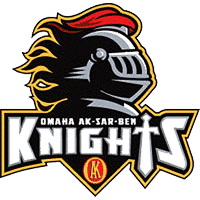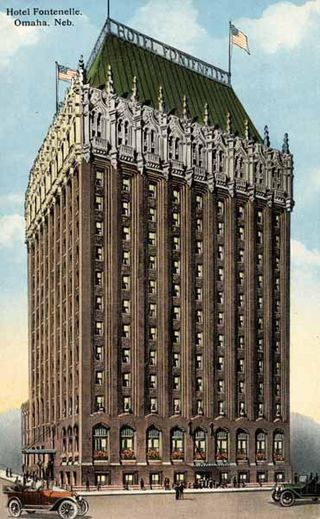
Kiewit Corporation is an American privately held construction company based in Omaha, Nebraska founded in 1884. In 2021, it was ranked 243rd on the Fortune 500. Privately held, it is one of the largest construction and engineering organizations in North America. It is an employee-owned company.

The CHI Health Center Omaha is an arena and convention center in the central United States, located in the North Downtown neighborhood of Omaha, Nebraska. Operated by the Metropolitan Entertainment & Convention Authority (MECA), the 1.1-million-square-foot (100,000 m2) facility has an 18,975-seat arena, a 194,000 sq ft (18,000 m2) exhibition hall, and 62,000 sq ft (5,800 m2) of meeting space.

The Omaha Ak-Sar-Ben Knights were a professional ice hockey team in the American Hockey League. They played in Omaha, Nebraska, United States at the Omaha Civic Auditorium from 2005–2007. Following the 2006–07 season, the Calgary Flames announced that the team would relocate to the Quad Cities for 2007–08.

Omaha Civic Auditorium was a multi-purpose convention center located in Omaha, Nebraska. Opened in 1954, it surpassed the Ak-Sar-Ben Coliseum as the largest convention/entertainment complex in the city, until the completion of CHI Health Center Omaha in 2003. With the opening of the Ralston Arena in 2012, all teams that played at the Civic Auditorium moved, which reduced the venue's viability. The auditorium closed its doors in June 2014 and was demolished two years later.

The Ak-Sar-Ben Race Track and Coliseum was an indoor arena and horse racing complex in the central United States, located in Omaha, Nebraska.
The Ak-Sar-Ben Zephyr was a streamlined passenger train operated by the Chicago, Burlington and Quincy Railroad (CB&Q) between Lincoln, Nebraska and Chicago, Illinois, United States. The first version operated from 1940 to 1947; a revived service operated from 1953 to 1970. The "Ak-Sar-Ben" portion of name was created by spelling Nebraska (Neb-ras-ka) backwards and taken from a fraternal organization of the same name. "Zephyr" was a name applied by the CB&Q to many of its trains, beginning with the Pioneer Zephyr in 1934. The name derived from "Zephyrus", the Greek god of the west wind.

The Ak-Sar-Ben Bridge was a Whipple through truss bridge that was the first road bridge to cross the Missouri River connecting Omaha, Nebraska and Council Bluffs, Iowa. It was replaced in 1966 by the Interstate 480 girder bridge.

The Nebraska State Fair is the state fair of the U.S. state of Nebraska. It is held annually in Grand Island, approximately 100 miles west of the state capital of Lincoln, which hosted the fair until 2010. The fair usually runs for 11 days, and since the early 1990s it has ended on Labor Day.
Eugene C. Eppley also known as Gene, was a hotel magnate in Omaha, Nebraska. Eppley is credited with single-handedly building one of the most successful hotel empires, by the 1950s the largest privately owned hotel chain in the United States.

The history of Omaha, Nebraska, began before the settlement of the city, with speculators from neighboring Council Bluffs, Iowa staking land across the Missouri River illegally as early as the 1840s. When it was legal to claim land in Indian Country, William D. Brown was operating the Lone Tree Ferry to bring settlers from Council Bluffs to Omaha. A treaty with the Omaha Tribe allowed the creation of the Nebraska Territory, and Omaha City was founded on July 4, 1854. With early settlement came claim jumpers and squatters, and the formation of a vigilante law group called the Omaha Claim Club, which was one of many claim clubs across the Midwest. During this period many of the city's founding fathers received lots in Scriptown, which was made possible by the actions of the Omaha Claim Club. The club's violent actions were challenged successfully in a case ultimately decided by the U.S. Supreme Court, Baker v. Morton, which led to the end of the organization.

Sports in Omaha, Nebraska are supported by a high attendance at events and tax support from the City of Omaha. Omaha, Nebraska is home to several professional sports teams and modern sports venues.

The economy of Omaha, Nebraska is linked to the city's status as a major commercial hub in the Midwestern United States since its founding in 1854. Dubbed the "Motor Mouth City" by The New York Times, Omaha is widely regarded as the telecommunications capital of the United States. The city's economy includes agriculture, food processing, insurance, transportation, healthcare and education. Warren Buffett of Berkshire Hathaway has lived in Omaha all of his life, as have the ConAgra Foods, Union Pacific Railroad and Mutual of Omaha Companies, and Kiewit Corporation, all Fortune 500 corporations.
The University of Nebraska Curling Club is the collegiate curling team that represents the University of Nebraska-Lincoln. They are an officially recognized organization on the campus in Lincoln, and are affiliated with the Aksarben Curling Association. Their home arena is Baxter Arena in Omaha, Nebraska. The team, founded in late 2007, practices at the Breslow Ice Hockey Center near main campus. They are coached by Nancy Myers and led by president Olivia Schuster and vice president Seamus Hurley.

The NP Dodge Company This story begins with one of the greatest brother acts ever seen in these parts – Grenville and Nathan Phillips Dodge.
The Omaha and Council Bluffs Railway and Bridge Company, known as O&CB, was incorporated in 1886 in order to connect Omaha, Nebraska with Council Bluffs, Iowa over the Missouri River. With a sanctioned monopoly over streetcar service in the two cities, the O&CB was among the earliest major electric street railway systems in the nation, and was one of the last streetcar operators in the U.S., making its last run in 1955.
Gambling in Omaha, Nebraska has been significant throughout the city's history. From its founding in the 1850s through the 1930s, the city was known as a "wide-open" town, meaning that gambling of all sorts was accepted either openly or in closed quarters. By the mid-20th century, Omaha reportedly had more illicit gambling per capita than any other city in the nation. From the 1930s through the 1970s, the city's gambling was controlled by an Italian criminal element.

Aksarben Village is a mixed-use development in the central United States, located in Omaha, Nebraska. Measuring over one million square feet (93,000 m2), it is on the land of the former Ak-Sar-Ben coliseum and horse track.
Isaac White Carpenter Jr. was American business executive and federal political appointee. He was the president of the Carpenter Paper Company in Omaha, Nebraska, for over 20 years, retiring in 1961 when the company was sold. He served in the Eisenhower administration as Assistant Secretary of State for Administration from 1954 to 1957.
Ak-Sar-Ben or Aksarben may refer to:

Although there is anecdotal evidence of an amateur radio club in Omaha prior to World War II, The Ak-Sar-Ben Amateur Radio Club (AARC), as it exists today, was started in 1945 and has been affiliated with the American Radio Relay League (ARRL) since that time. The club is not affiliated with The Knights of Ak-Sar-Ben.













